Japan
Wood Products Prices
Dollar Exchange Rates of 25th
May
2024
Japan Yen 170.09
Reports From Japan
Majority of Japanese firms
say weak yen hurts profits
According to a recent survey of over 1,000 companies by
Teikoku Databank and reported in the Japan Times, many
consider the weak yen is not good for business.
About 64% of firms surveyed said the weak yen has
eroded their profits, while just 78 firms saw a positive
impact. Companies citing a negative impact said they were
unable to pass on rising raw materials costs to customers.
Most companies suggested a yen trading around yen 110-
120 to the dollar would be appropriate. At the end of May
the yen was 157 to the US dollar.
While the weak yen has bolstered earnings by exporters it
continues suppress domestic spending. Household
spending has fallen every month for more than a year.
See:
https://www.businesstimes.com.sg/international/majority-japanese-firms-says-weak-yen-hurts-profits-survey
Calls for stepping up structural reforms
Masato Kanda, speaking before a meeting of Group of 7
finance ministers and central bankers, pointed out that
Japan needs to make its economy more internationally
competitive and at the same time he urged economic
reform to tackle structural issues seen as pulling down the
yen exchange rate.
Kanda emphasised the need to push ahead with wage
increases, create conditions for increased capital spending
and strengthen job market mobility.
See:
https://asia.nikkei.com/Editor-s-Picks/Interview/Japan-top-currency-diplomat-calls-for-stepping-up-structural-reforms2
IMF - upturn in consumption forecast for later this year
In early May the International Monetary Fund (IMF)
concluded the Article IV consultation with Japan this
included discussion of the findings of the Financial Sector
Assessment Program (FSAP) for Japan.
The IMF noted the Japanese economy has continued to
recover since the pandemic with broad-based price
increases following three decades of low inflation.
Growth is expected to continue with an upturn in
consumption forecast for later this year. For 2024 growth
is projected to decelerate to 0.9% but consumption is
expected to pick-up in the latter half of 2024 and in 2025
due to the combination of rising nominal wages and lower
inflation which will lift disposable incomes.
See:
https://www.imf.org/en/News/Articles/2024/05/13/pr24156-japan-imf-executive-board-concludes-2024-article-iv-consultation?utm_medium=email&utm_source=govdelivery
and
https://www.imf.org/en/News/Articles/2024/02/08/mcs020824-japan-staff-concluding-statement-of-the-2024-article-iv-mission
Higher exports but trade deficit
The value of Japan's exports grew for the fifth consecutive
month in April, according to the Ministry of Finance.
Exports of automobiles increased by 18%, semiconductor
manufacturing equipment rose 28% and exports of
electronic components including semiconductors were up
20%.
However, Japan recorded a trade deficit of around US$3
billion in April as higher crude oil prices and a sharp drop
in the yen exchange rate drove up the value of imports
offsetting robust export growth.
See:
https://asia.nikkei.com/Economy/Japan-exports-grew-for-5th-month-in-row-in-April-led-by-cars-chips
First quarter dip in GDP
The Japanese economy shrank year on year at an annual
rate of 2% in the first quarter of this year. Although
unemployment remains low wage growth has been slow
and prices have risen due to weakness of the yen against
the US dollar.
Quarter-on-quarter, the preliminary seasonally adjusted
GDP, a measure of the value of a nation’s products and
services, slipped 0.5% in the January-March period
according to the Cabinet Office.
See:
https://apnews.com/article/japan-economy-inflation-gdp-yen-bb372c3c9d79c31b8a5accb0a650b822
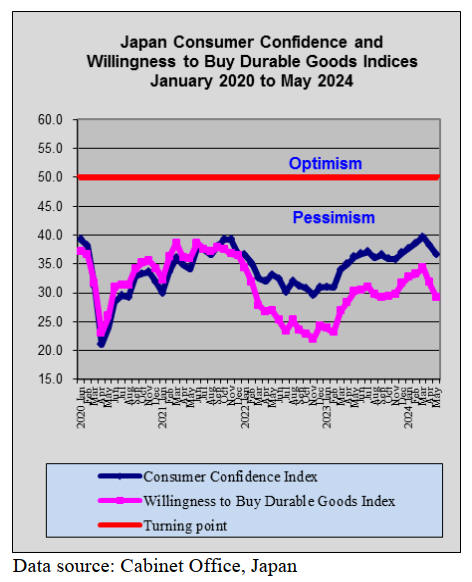
Interest rate hike may come earlier than
anticipated
When the Bank of Japan (BoJ) began unwinding its
negative interest policy in March this year it emphasised
that financial conditions would be kept easy and interest
rates would only slowly increase.
But that was before the yen/dollar exchange rate crashed
and remains weak despite two suspected currency
interventions and the BoJ reduced its purchases of
Japanese government bonds.
The BoJ policy statement also came as the US Federal
Reserve stated there will only be three interest rate cuts
this year, down from the six that were anticipated. These
changes have increased the possibility that interest rates in
Japan may be raised earlier than expected, especially as
the weak yen is at the heart of the higher prices faced by
consumers.
See:
https://asia.nikkei.com/Spotlight/Market-Spotlight/Potential-for-earlier-BOJ-rate-hike-rises-amid-hawkish-signals-weak-yen
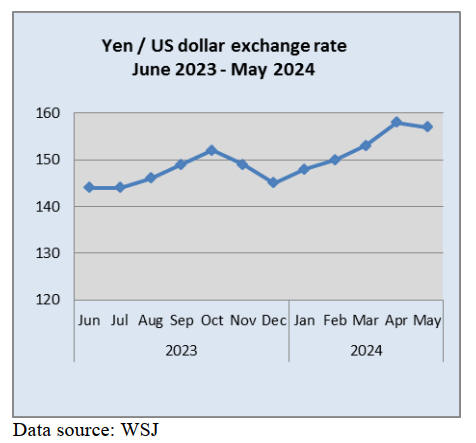
Carbon footprint in constructing wooden house
Researchers at Kyushu University have published a
comprehensive analysis on the carbon footprint of
constructing a wooden house in Japan. The study covered
the total amount of emissions produced along the entire
supply chain including the processing and transport of the
raw materials that go into building a house.
According to the team's findings, “the estimated carbon
footprint of building a single wooden house in Japan is 38
tonnes of CO2. Making up the largest share of that,
accounting for 32% of total emissions, was the electric
power sector. Other sectors included iron production at
12%, with cement, road freight transport and private
power generation each producing around 7% of total
emissions”.
See:
https://phys.org/news/2024-05-carbon-footprint-wooden-house-japan.html#google_vignette
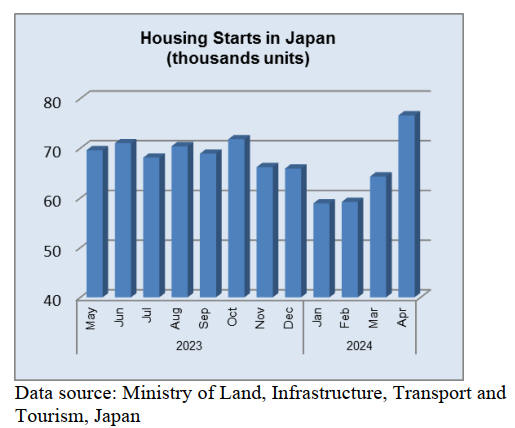
Import update
Log and sawnwood imports
Japan has a long history of tropical timber imports. It was
from the Philippines that Japan first imported tropical
timber, starting in the 1950's and peaking in the second
half of the 1960's.
Japan used to be the world's biggest consumer of tropical
logs but in 2023 imports had dropped to 30,759 cu.m from
a peak of 26.79 million cu.m in 1973. More than half of
2023 log imports came from Malaysia with the balance
from 12 other countries.
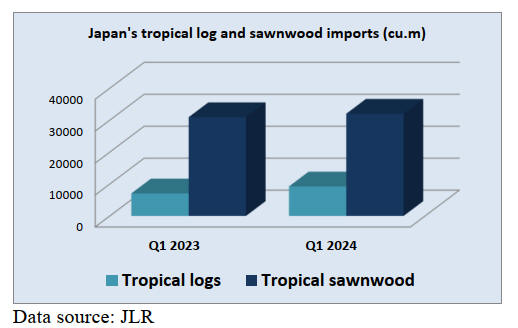

First quarter 2024 tropical sawnwood
imports
Imports of tropical sawnwood have followed the same
downward trend as seen for tropical logs. In 2013 tropical
sawnwood imports were around 280,000 cu.m but dropped
to 136,000 in 2023.
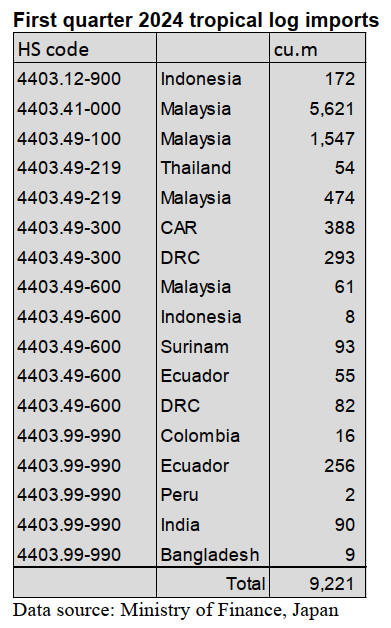
Import update
Assembled wooden flooring imports
In March the main category of assembled flooring imports
was (HS441875), accounting for over 70% of the total
value of assembled flooring imports. The second largest
category in terms of value was HS441873 exceeding that
of HS 441879.
The value of imports of assembled wooden flooring
(HS441871-79) in March 2024 were up from the same
month in 2023 and compared to the value of February
imports there was a 15% increase in the value of Marchy
imports.
The yen exchange rate against the US dollar has driven up
the cost of flooring imports but the steady rise in imports
cannot be explained as only due to the weak yen as the yen
exchange rate has been in the range of 140-150 yen per
dollar for most of 2023 rising to over 150 in the early part
of 2024.
The main shippers of assembled flooring in February were
China 58%, down slightly from a month earlier, Vietnam,
Malaysia, Thailand and Indonesia.

Plywood imports
Of the four main suppliers of plywood (HS441210-39) to
Japan; Indonesia, Malaysia, Vietnam and China all except
for Indonesia saw March shipments drop below those of
the previous month. However, the total volume of March
imports fell from the previous month but were up year on
year.
Of the various categories of plywood imported, 83% was
HS441231 in March with HS441233 and HS441234
accounting for the balance. The four main shippers of
plywood to Japan, Indonesia, Malaysia, Vietnam and
China consistently account for over 90% of plywood
imports.


Trade news from the Japan Lumber Reports (JLR)
The Japan Lumber Reports (JLR), a subscription trade
journal published every two weeks in English, is
generously allowing the ITTO Tropical Timber Market
Report to reproduce news on the Japanese market
precisely as it appears in the JLR. For the JLR report
please see:
https://jfpj.jp/japan_lumber_reports/
Japan Novopan Industrial to raise price of products
Japan Novopan Industrial Co., Ltd. in Osaka Prefecture
will raise the prices of all kinds of particleboards gradually
starting June, 2024. The prices of all kinds of
particleboards will be 10 % higher than the current prices.
The reasons are that the prices of materials, such as glue or
wooden chips, glue, production cost and transportation fee
are rising.
The company will change the price of 2 x 6 floor at first.
Then, the prices of products for woodworking, structural
materials for prefabricated houses, and structural
particleboards will be raised. The company expects clients
to understand this price hike.
According to the company, the price of wooden chips has
increased 14 % since the beginning of this year. The price
of glue has increased 4 %. The prices of a curing
accelerator, mold release agent, sales, general and
administrative expenses, and labor costs have increased 2
%. The price of distribution costs has increased 5 %.
After the invasion in Ukraine by Russia, the price of
petroleum and LNG rose and the price of petrochemical
products also rose. Additionally, the yen started to
depreciate against the dollar in this year. Also, prices for
everything keep increasing. Then, the company raised
wages for its employees.
The annual production of particleboards is 150,000 –
160,000 tons at Sakai plant, which is a head plant, in
Osaka Prefecture and the annual production of
particleboards is 120,000 tons at Tsukuba plant in Ibaraki
Prefecture. Japan Novopan Industrial is one of the greatest
particleboard manufacturers in Japan.
Akimoku Board stopped producing hardboards and
insulation boards
Since the hardboard and insulation board markets have
been shrinking, Akimoku Board Co., Ltd. in Akita
Prefecture has decided to voluntarily close its business and
has stopped producing hardboards and insulation boards at
the end of April, 2024.
The company was established in 1999. The company
manufactured boards by a wet process. The hardboards
were used for crating and curing boards for floors and the
insulation boards were used for tatami boards.
Monthly production of hardboards was 400 – 450 tons and
monthly production of insulation boards was 200 – 250
tons.
The reasons for stopping manufacturing insulation boards
were that Japanese – style rooms were not popular and the
COVID-19 or the woodshcok influenced the new starts
after 2020. The sales of insulation boards went down
badly.
South Sea logs and lumber
Since demand for blocks for steel ship building is high
shipbuilding is high, demand for south Sea log is very
strong. South Sea log is very strong blocks for steel is
popular and South Sea log is the best material to produce
the blocks.
The arrival volume of South Sea logs during January to
February 2024 is 7,985 cbms, 13,4% higher than the same
period last year. Next South Sea logs will arrive to Japan
in June or July 2024.
The price of log in South East Asia increases due to the
weak yen. Is difficult to sell South Sea log with good
quality to Japanese buyers. Malaysia plywood
manufacturers have reduced production so loggers hesitate
to cut down trees. Also, loggers in PNG lost their
motivation to cut down trees because demand logs in
China is sluggish.
Once the yen depreciated to 155 yen against the dollar
many distributors started to purchase South Sea lumber
and Chinese lumber because they assumed the yen would
appreciate against the dollar easily.
March supply of plywood
Total plywood supply in March, 2024 is 361,000 cbms.
This is 4.4 % less than February, 2024 and this is straight
four months decreasing. Domestic plywood is 2.0 % down
from the previous month and imported plywood is 7.1 %
down from the previous month.
On the other hand, shipment of domestic plywood is 8.5 %
higher than last month and this is for the first time in three
months to be a level of 200,000 cbms. The inventory at the
end of April, 2024 decreases.
Production of structural softwood plywood is 174,000
cbms, 2.6 % less than last month. Production of under 6
mm plywood, under 6 – 12 mm plywood, under 12 – 24
mm plywood, and over 24 mm plywood has decreased
from the previous month.
However, shipment of plywood is 20,000 cbms, 12.4 % up
from last month. The shipment exceeds production by
9,000 cbms. Production of domestic painted plywood for
concrete form is 2,300 cbms higher than the previous
month.
This was the largest volume of domestic painted plywood
for concrete form for the first time since June, 2023.
The market of structural softwood plywood had been very
sluggish until the middle of March, 2024. However,
several major plywood manufacturers announced to raise
the structural plywood price as of April, 2024.
Then, consumers started to purchase the structural
plywood so the movement of structural plywood began to
move. The imported plywood supply decreases for two
months continuously. Indonesian plywood is 11.2 % down
from last month but Malaysian plywood is 10.5 % up from
last month.
The average Indonesian plywood supply during January,
2024 to March, 2024 is 60,000 cbms. The average
Malaysian plywood supply during January, 2024 to
March, 2024 is 48,000 cbms.
Since the inventory of domestic plywood soared in 2023,
the average Indonesian plywood supply during January,
2023 to March, 2023 was 52,000 cbms. The average
Malaysian plywood supply during January, 2023 to
March, 2023 was 38,000 cbms.
FSC structural cypress plywood
Japan Kenzai Co., Ltd. in Tokyo Prefecture starts selling
12 3 x 6 domestic structural cypress plywood, which has
the JAS (Japanese Agricultural Standards) certification
and has the FSC (Forest Stewardship Council)
certification. The new plywood is an eco-friendly product.
Noda Corporation in Tokyo Prefecture manufactures
plywood. This new plywood is sold in Kanto region
mainly and in Chubu region.
The new plywood consists of five layers. Cypress is used
on front face and back side. Cedar is used for the second
and the fourth layers. Cedar or cypress is used in the
center of the new plywood. Cypress is not infected with
insects easily and it is easy to manufacture products.
In Japan, supply volume of domestic plywood exceeded
supply volume of imported plywood in 2016. The
company expects to expand selling the new plywood.
|